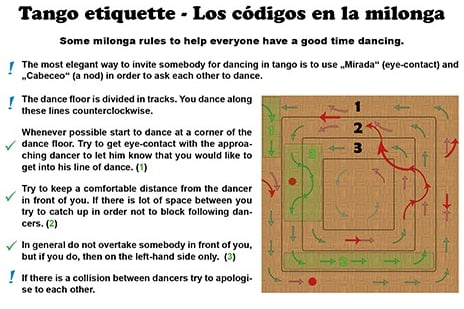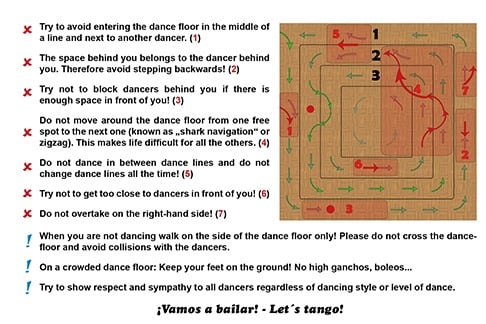Tango Codes... What are they for?
Today we are going to talk about the “codes”. The codes are the dance etiquette developed over the years in the milongas.
For sure that many of you think that is something oldfashioned and rude, but many of them comes from the common sense and help dancers to organize the space that we share. The codes are functional %100 and can make us the things easy if we use it in the correct way. In the milongas (tango dance parties) a DJ, use to play music in “tandas” (sets), separated by “cortinas” (curtains). Tandas are sets of 3 or 4 songs played by one orchestra (same orchestra, same period, and same singer - if there is one-). The cortina between tandas is a short piece of non-tango music.
The Cabeceo
In Tango to ask someone to dance, we catch the eye of the person we want to dance with and nod their head. If the other person accepts the invitation they will nod back. If person does not want to dance for any reason, they will subtly look away, or not look toward that person to begin with. The cabeceo ensures that no one dances out of obligation, and avoids rejection and hurt feelings. In traditional milongas of Buenos Aires, directly asking someone to dance is considered rude and is usually rejected. The lider could stand to get a better view, or walk around the room to get closer to the follower wants to ask to dance. But the leader still does the cabeceo from a distance and makes sure the follower has a mutual interest in dancing with him. If the follower accepts the invitation, the leader walks over to meet the follower. The follower should stay seated and maintain eye contact with the leader until the leader meets the follower. This will avoid embarrassing situations where the cabeceo was intended for someone sitting next to the follower. At the end of the tanda, the leader will accompany his/her partner back to her seat. The cabeceo happens at the beginning of the tanda, not during a cortina. This way, everyone is aware of what kind of music they may be committing to.
Navigation
The dance proceeds counter-clockwise around the dance floor, referred to as the ronda or line-of-dance. Typically there is an outside lane and if the floor is crowded second and third inside lanes may form. Navigating in a cooperative way helps everyone feel safe and able to focus on their partners and the dance. Bad navigation causes other dancers to spend their time protecting their partners from potential harm.
Here are some tips for good navigation:
Leaders entering the floor when people are dancing should make eye contact with the leader that they want to enter in front of.
Share the dance floor responsibly.
Leaders stay aware of the couples around you.
Dance forward at the speed of the couple in front of you.
Do not tailgate the couple in front of you, if possible, keep a two step gap between you and the couple in front of you.
Move into any gap in front of you, so that those behind you have room to move forward.
Adjust the amount of space you use to how crowded the floor is.
When the floor is very crowded, keep your steps small, keep your feet on the floor (e.g. no high boleos), and don’t leave large gaps between you and other couples. If the floor is less crowded, increase the distance between couples and you may choose to take steps that use more room.
Stopping for long periods of time to do numerous dance patterns is rude since it stops the line of dance and will frustrate leaders behind you.
Only pass a couple under extreme circumstances.
If a couple in front of you stops, be patient and dance in place until they move. Avoid changing lanes. Do not weave in and out of lanes.
Never cut across the floor. Never back up against the line of dance.
Some Codes Tips:
Take time to connect with the music and your partner before you start dancing.
Do not rush into the dance right at the start of the music. ·
The leader will start the embrace when he/she is ready to begin the dance. Followers should wait for this.
Do not dance during a cortina. Everyone should clear the floor during cortinas. Do not enter the dance floor until the cortina has ended.
When you agree to dance with someone you agree to dance the entire tanda. No one changes partners in the middle of a tanda. However, no one should subject themselves to a terrible experience. If you wish to stop dancing with someone, do so by thanking them at the end of the song and walking back to your seat. Saying “Thank you” before a tanda is over is understood as “I no longer want to dance with you.”
Good leaders dance at the level of the follower they are dancing with. It is rude to dance above her level to impress her, show off to others, or boost one’s ego.
Teaching on the dance floor is extremely rude and not allowed. It disrupts other dancers and is disrespectful to your partner. Even a well-intended comment can ruin your partner’s evening. If you feel a need to instruct, save it for a practica, and only give advice when you are asked for it.
Never ask for advice, corrections, or teaching on the dance floor from anyone. Milongas are never a place for instruction.
No one likes being kicked, run into, hit, or stepped on. Milongas are supposed to be safe places where people can dance freely and comfortably. Save the high boleos, hard-hitting ganchos, jumps, leg sweeps and leg extensions for performances.
If a collision occurs, be polite and friendly. Make eye contact and acknowledge the collision even if it was not your fault. If it was clearly your fault, apologize at the end of the song.
If you are not dancing, show respect to those who are by not walking across the dance floor or standing on the floor talking.
Good hygiene is essential. Before going to a milonga, bathe, shave, brush your teeth, use deodorant, and put on fresh clothes. If you perspire, use a towel or handkerchief often. If you perspire heavily, use a towel, take breaks to cool down, bring an extra shirt, and change into when needed.
If you wear glasses, consider contact lenses or removing your glasses while dancing unless you can’t see without them.
Nowadays it is common to hear that the codes are sexist or that they do not make sense, but if we pay attention the codes allow us to decide what both want to do (leaders and followers), respecting the decision of the other in a respectful way. Some codes may be affected by each context, but it is always good to know that they exist and that they were created with the purpose of maintaining order on the court and respectfully enjoying the shared moment.




